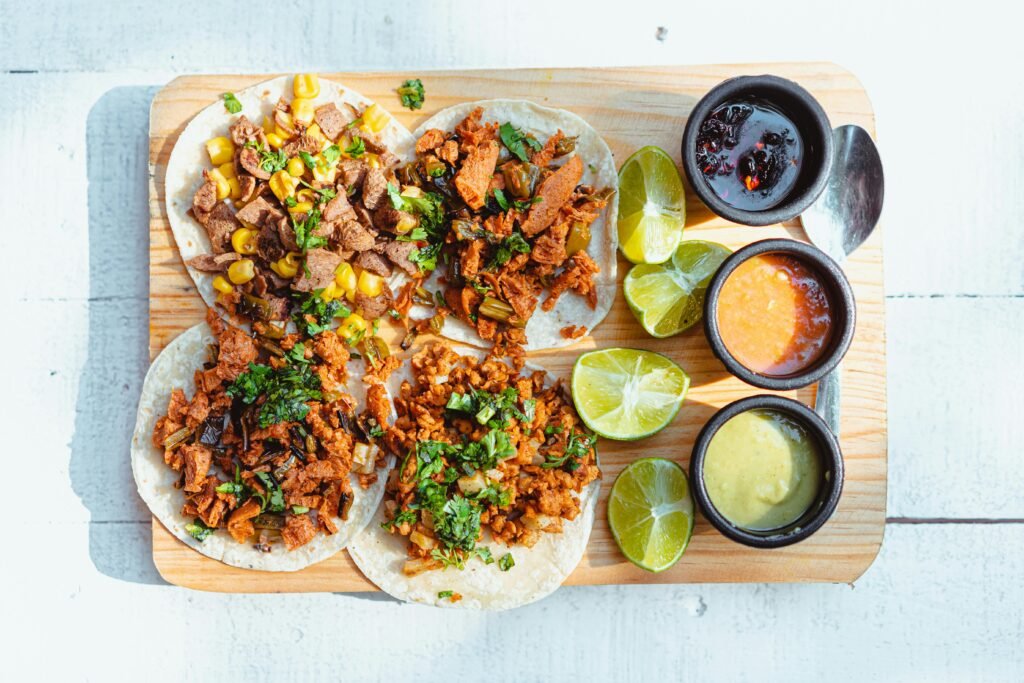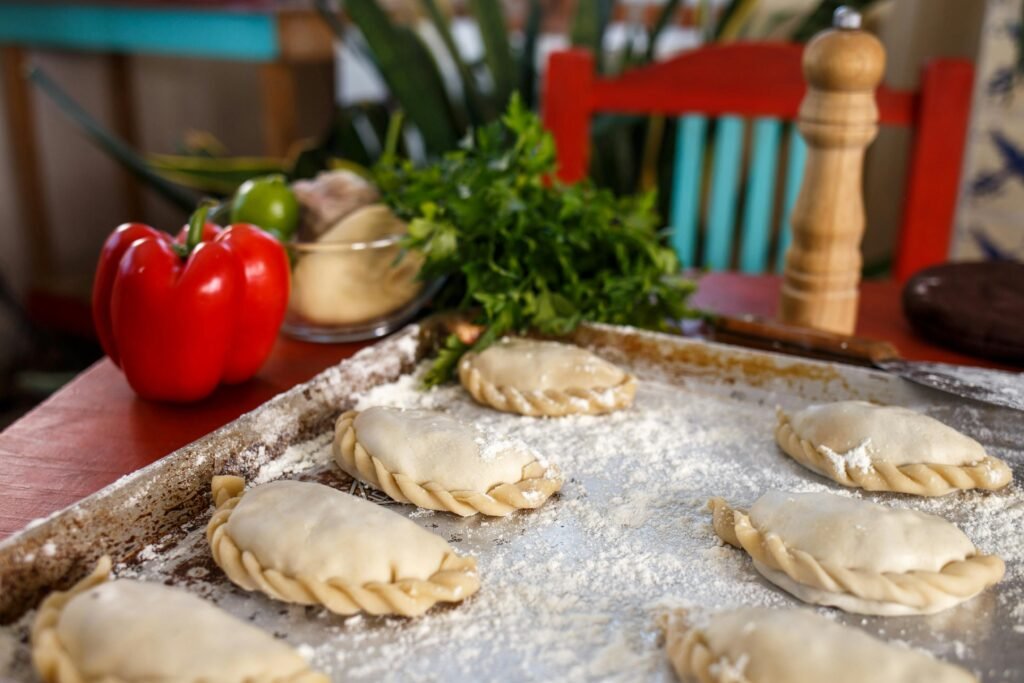Introduction to Street Food Culture in Latin America
The street food culture in Latin America is a vibrant and integral part of the region’s culinary landscape, deeply rooted in its history and traditions. This phenomenon, characterized by a plethora of flavors and cooking styles, plays a significant role in daily life for many Latin Americans. Street food vendors are found in bustling markets, alongside busy streets, and at community events, offering an array of delightful dishes that embody local ingredients and culinary techniques.

Street food in Latin America is more than just a convenient option for meals; it represents a rich tapestry of cultural expression. Each region boasts its unique specialties, influenced by indigenous practices, colonial histories, and modern gastronomic trends. For instance, one can find tacos in Mexico, empanadas in Argentina, and arepas in Venezuela, each item reflecting the distinct heritage of its origin. These offerings not only tantalize the taste buds but also tell the story of the local community’s customs and traditions.
Furthermore, street food serves as a crucial social platform, where people gather to enjoy meals, share stories, and forge connections. Markets and street corners become festive atmospheres filled with laughter and conversation, illustrating how food has the power to bring people together. In many Latin American countries, it is common to see families and friends sharing a meal from a street vendor, reinforcing communal bonds and fostering a sense of belonging.
Moreover, affordability is a key attribute of street food, making it accessible to a diverse demographic. This economic aspect not only supports local vendors but also allows culinary enthusiasts to experience authentic flavors without breaking the bank. Street food thus stands as a testament to the resilience and creativity of communities, showcasing how culinary traditions can thrive in urban environments. Through this exploration of Latin America’s street food culture, one gains a deeper appreciation for the unique blend of flavors, history, and community spirit that encapsulates this gastronomic journey.
Tacos al Pastor: Mexico’s Iconic Street Treat
Tacos al Pastor stands out as one of Mexico’s most beloved street foods, a dish that fuses traditional Mexican flavors with influences from Lebanese cuisine. This iconic taco is characterized by its marinated pork—a staple protein richly spiced with garlic, cumin, paprika, and other seasonings. The marination process allows the meat to absorb these flavors profoundly, resulting in a succulent filling that defines the essence of this dish.

The preparation of Tacos al Pastor involves a unique cooking method that is reminiscent of shawarma. The marinated pork is stacked onto a vertical spit, known as a trompo, where it is slowly cooked. As it roasts, the outer layer becomes crispy, while the inner meat stays juicy and tender. What sets Tacos al Pastor apart is the addition of pineapple, which not only enhances the flavors with a touch of sweetness but also caramelizes as it cooks, adding another dimension to the dish. Once ready, the meat is shaved off the spit and typically served on warm corn tortillas, topped with onions, cilantro, and a squeeze of lime.
In Mexico City, which is considered the epicenter for Tacos al Pastor, one can find numerous taquerías specializing in this dish. Notable establishments include El Huequito, known for its signature spicy sauce, and Taquería Los Parados, where the tacos are served with generous portions of pineapple. Such locations attract both locals and tourists eager to indulge in authentic flavors. Overall, Tacos al Pastor exemplifies the vibrant culinary culture of Mexico and remains a must-try street food for anyone seeking an unforgettable gastronomic experience.
Empanadas: Argentina’s Hand-Held Delights
Empanadas are one of the most iconic foods in Argentina, serving as a perfect representation of the country’s rich culinary heritage. These hand-held pastries are characterized by their dough, which encloses a variety of savory fillings, making them a versatile snack that appeals to all tastes. Traditionally, empanadas are made using wheat flour, producing a flaky crust that enhances the overall eating experience.

The fillings of empanadas can differ significantly based on the region. In the north, for instance, one might find empanadas filled with spicy meats, potatoes, or cheese, reflecting the bold flavors derived from indigenous influences. Conversely, in places like Buenos Aires, the empanadas might contain fillings like minced beef, onions, olives, and hard-boiled eggs, showcasing a blend of European and local culinary traditions. These fillings are seasoned to perfection, and each bite offers a unique taste experience that embodies the essence of Argentine food culture.
Cooking methods also vary, with empanadas being either baked or fried. Baked empanadas are lighter and often considered healthier, while fried versions boast a golden, crispy exterior that many find irresistible. The preparation method often depends on local customs; for example, the empanadas from Salta are generally larger and have thicker crusts, while those from Mendoza tend to be smaller and more delicately crafted. Regardless of the style, empanadas remain a beloved street food option in Argentina.
In Buenos Aires, numerous street vendors offer some of the best empanadas in the country. Notable spots include “El Sanjuanino,” famous for its beef empanadas, and “Los Rios,” where visitors can taste traditional varieties that reflect the diverse flavors of Argentina. Exploring these street stalls is essential for anyone wishing to savor authentic Argentine empanadas and immerse themselves in the lively atmosphere of Argentine street food culture.
Arepas: Venezuela’s Versatile Corn Cakes
Arepas are a quintessential culinary staple of Venezuela, cherished for their versatility and delightful taste. These corn cakes, made from pre-cooked corn flour, can be prepared in various ways, including grilled, baked, or fried, each method offering a unique texture and flavor profile. What makes arepas especially appealing is their adaptability; they can be filled with an array of ingredients, allowing individuals to tailor them to their preferences.

In their simplest form, arepas are unfilled and can accompany other dishes, but the true charm of arepas lies in their extensive range of possible fillings. Traditionally, they can be stuffed with shredded beef, chicken, or pork, all accompanied by tasty toppings like avocado, cheese, or black beans. Options such as reina pepiada — a mixture of shredded chicken with avocado and mayonnaise — have gained immense popularity and are widely available. Additionally, the vegetarian variants, featuring fillings such as beans, cheese, or sautéed vegetables, cater to a wider audience, reinforcing the arepa’s inclusivity as a street food option.
In Caracas, the capital of Venezuela, the quest for the most authentic arepas leads food enthusiasts to numerous locales renowned for their culinary prowess. Streets and markets are dotted with vendors specializing in this iconic dish, where the preparation methods are often passed down through generations. In areas such as El Bosque and La Candelaria, enthusiasts can find numerous stands that serve freshly made arepas with a vast selection of fillings, reflecting the rich culinary heritage of the region. The daily enjoyment of arepas showcases not only their significance in Venezuelan daily life but also highlights their role in fostering community and cultural identity. As such, exploring arepas is not simply a gastronomical experience; it is a gateway to understanding the essence of Venezuelan culture and tradition.
Ceviche: A Fresh Taste of the Coast
Ceviche stands as one of the most iconic dishes throughout Latin America, particularly celebrated in Peru, where it originates. This dish primarily comprises fresh raw fish cured in citrus juices, typically lime or lemon, and is exquisitely seasoned with various spices and ingredients, including cilantro, onion, and chili peppers. There are numerous variations of ceviche, each with its unique twist, resonating with the diverse coastal cultures across the region. For instance, Peruvian ceviche is noteworthy for its spicy kick and often includes side accompaniments such as sweet potatoes, corn, or avocado.

The freshness of seafood plays a crucial role in preparing top-notch ceviche. Commercial fish markets or local fishermen’s catches are frequently trusted sources for high-quality ingredients. The most popular fish used in ceviche are often white, firm-fleshed varieties, including tilapia, sea bass, or snapper—the choice, however, varies according to regional availability. In Lima, a city renowned for its cevicherias, one can find establishments dedicated solely to perfecting this national dish. The preparation of ceviche is generally simple, requiring only the freshest fish, citrus juice, and a minimalist approach to allow the inherent flavors to shine.
Some of the highly regarded cevicherias in Lima include Pescados Capitales, known for its traditional approach and generous portions. Another popular spot is La Mar, where ceviche aficionados rave about its zesty flavor and authentic preparation style. At these famed venues, one can taste the essence of Peruvian culinary culture encapsulated in a bowl of ceviche, making it an essential experience for any visitor. Ultimately, sampling ceviche in its homeland offers a fresh taste of the coast, exemplifying the natural flavors and rich gastronomic heritage of Latin America.
Churros: Sweet Street Snacks from Spain to Latin America
Churros, a beloved sweet treat, have traveled from their origins in Spain to become a staple of street food culture in many Latin American countries. Traditionally, churros are long, fried pastries, often dusted with sugar and accompanied by a rich chocolate dipping sauce. This iconic dessert not only captivates taste buds but also weaves a narrative of cultural exchange and adaptation as it takes on various forms across different regions.

In Spain, churros are frequently enjoyed for breakfast, paired with thick hot chocolate. However, in Latin America, the preparation and serving style of churros have evolved, reflecting local tastes and preferences. For example, Mexican churros are often filled with dulce de leche or chocolate, enhancing the original recipe with additional layers of flavor. They can be found in numerous street stalls and markets, attracting both locals and tourists eager to savor this delightful snack.
In countries like Argentina and Venezuela, churros also hold a special place. In Argentina, you can find them as “churros” or “churros rellenos,” which are filled with sweet fillings such as cream or melted chocolate. Meanwhile, Venezuelan vendors often serve churros with a side of “ajo,” a sweet syrup that complements the fried dough’s crispiness. Each variation reflects the unique approach that different cultures take towards this universal dessert staple.
When searching for the best churros, Mexico City offers an array of artisanal options, particularly in the neighborhoods of La Condesa and Coyoacán. Notable establishments, such as El Moro, have become renowned for their exceptional churros and signature chocolate dip. Similarly, in Spain, the bustling streets of Madrid offer radiant churro cafes like Chocolatería San Ginés, where locals gather for a taste of tradition. Each bite of a churro serves not only to satisfy a sweet tooth but also to provide a glimpse into the rich culinary histories that shaped their evolution across continents.
Pani Puri: A Burst of Flavors from India to Latin America
Pani puri, a beloved street food originating from the Indian subcontinent, has captured the hearts and taste buds of food enthusiasts around the world, including those in Latin America. Traditionally, this snack consists of hollow, crispy puris filled with a spicy mixture of flavored water (pani), tamarind chutney, chickpeas, and potatoes. Over time, pani puri has evolved, with various regions of India introducing their unique spins, such as the addition of various spices and ingredients, making it a versatile and vibrant dish.
The adaptation of pani puri in Latin America demonstrates the rich fusion of cultures and cuisines. In countries with substantial Indian communities, like Peru and Brazil, this snack has found a significant place in the street food scene. Local vendors have embraced the concept of pani puri while incorporating distinct Latin flavors and ingredients. For instance, in Lima, vendors might include local avocados or fusion sauces in the filling, blending traditional elements with Peruvian culinary influences. Similarly, in São Paulo, green chilies from Brazilian cuisine may find their way into the spicy water, creating a unique twist that reflects the vibrant food culture of the country.
Finding the best pani puri stands in Latin America can often be an adventure, as these dishes frequently originate from family recipes passed down through generations. Areas surrounding Indian temples or cultural centers often host some of the most authentic pani puri vendors. In addition, food festivals celebrating Indian culture provide an excellent opportunity to sample this delightful snack. Whether through a traditional approach or modern adaptations, pani puri’s journey from India to Latin America is a testament to the universal love for tasty street food that brings communities together.
Street Markets: The Heart of Latin American Street Food
The vibrant street markets of Latin America serve as a gastronomic hub where local culture and culinary art converge. These bustling marketplaces create an atmosphere imbued with sensory experiences ranging from tantalizing aromas to the colorful vibrancy of food stalls. Each market is a microcosm of the community it represents, brimming with energy as vendors and customers interact, exchanging not just ingredients but stories and traditions. Street food stalls within these markets offer an impressive variety of options, showcasing local flavors and regional specialties that reflect the culinary diversity of the continent.
One of the most notable examples is La Merced in Mexico City, one of the largest and most traditional markets in the region. This marketplace teems with activity, presenting a myriad of food choices such as tacos, tamales, and fresh juices. The sheer scale of La Merced allows for numerous vendors to coexist, each offering their unique take on classic recipes. Visitors can indulge in a wide array of street foods, from the humble to the extravagant, all prepared before their eyes, ensuring an authentic experience. The market not only highlights the culinary heritage of Mexico but also serves as a vital source of fresh produce and goods for the local population.
Another remarkable destination is the Mercado Central in Santiago, Chile. Known for its bustling atmosphere, this market is renowned for its seafood, where visitors can sample delicacies such as ceviche and fried fish. The communal spaces within the market foster a sense of camaraderie among patrons who gather to savor not just the food, but the ambiance. Whether it is a casual lunch or an adventurous culinary exploration, Mercado Central encapsulates the vibrancy of Chilean street fare and the cultural significance of shared dining experiences.
Ultimately, these street markets are more than mere food venues; they represent the cultural narratives of their regions, inviting locals and tourists alike to explore the rich tapestry of Latin American street food. Each market experience offers an opportunity to delve into the daily life of the local community while enjoying some of the best flavors traditional to the area.
Conclusion: The Enduring Appeal of Street Food
The vibrant world of Latin American street food presents a culinary tapestry that is as rich in flavor as it is in culture. Each region boasts its unique specialties, reflecting the diverse ingredients, traditions, and histories of its people. From the empanadas of Argentina to the tacos al pastor of Mexico, there is an endless array of options that showcase the ingenuity and resourcefulness of local cooks. These tasty offerings not only tantalize the taste buds but also serve as a window into the heart of each community.
The significance of street food transcends mere sustenance; it embodies social interaction, tradition, and the sharing of culinary heritage. Streets bustling with vendors offer an invitation to try new flavors while engaging with the local culture. As people gather around food carts or in outdoor markets, they partake in a communal experience that fosters connection and celebration. This scene encapsulates the spirit of Latin America: vibrant, vivacious, and deeply rooted in community values.
For those eager to embark on their culinary journey, the world of Latin American street food awaits with open arms. Whether you are a seasoned traveler or a curious foodie, seeking out local recommendations will enhance your experience. Look for hidden gems recommended by locals or those bustling with crowds, as they often signal delicious authenticity. Exploring the colorful stalls and food trucks that populate the streets will not only satisfy your hunger but also deepen your appreciation for the culture from which these delectable dishes arise.
Ultimately, the enduring appeal of street food lies in its ability to bridge cultures, share stories, and bring people together over shared meals. So, take the plunge and allow the tastes of Latin America to guide you through a memorable culinary adventure.
